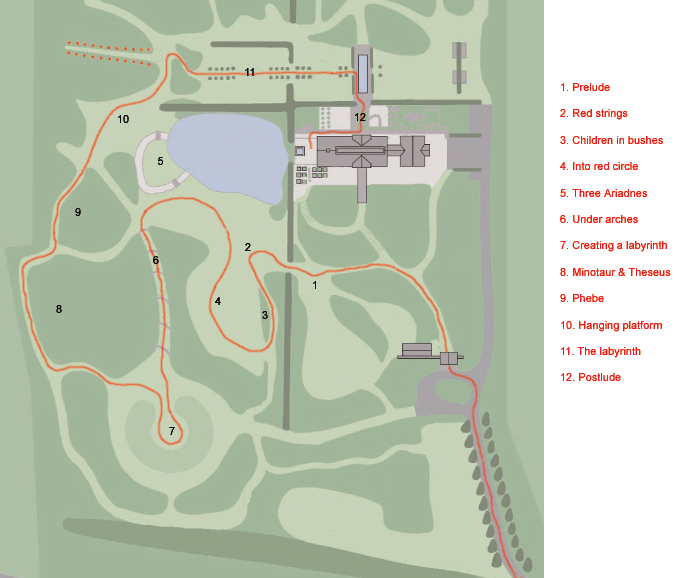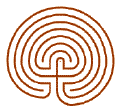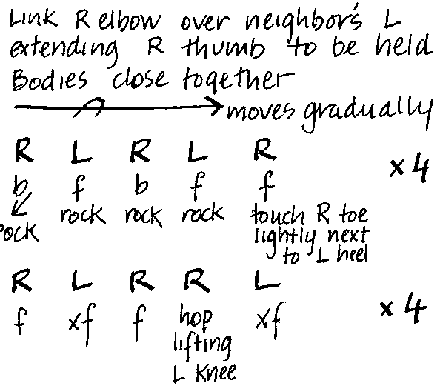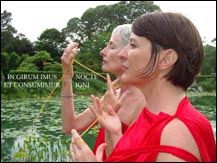07 AUG 04
Oddfellows Playhouse presents
"Systole & Diastole: Chambers of the Heart"
at the LongHouse Reserve, East Hampton, NY
Directed by Maria Pessino
Musical Score by Patrick GrantSystole & Diastole: Chambers of the Heart is a guided journey through the LongHouse Reserve Gardens at dusk. The performance will take place at site-specific locations set up by director Maria Pessino. The tapestry of performances will be woven with the threads of song, spoken word, visual and video arts, propelled along by an original score by composer Patrick Grant. At the end of the evening, the audience's footprints will have created an invisible path in space, the winding outline of the world's oldest maze: the event's main set-piece being a replica of the labyrinth that Theseus battled the Minotaur within on the island Crete in Greek mythology.
Map of the grounds as used in the piece
What is a maze?
Is it simply an intricate network of passages? In the ancient world it was more than this: The maze (or labyrinth) was a place of "planned chaos," where order and disorder existed simultaneously. To those unlucky enough to be lost in the maze, all is confusion. To those who can see its pattern from afar, however, the maze revealed its artistry and design.
Here is something to think about: the same juxtaposition of order and disorder, of artistry and chaos, that is apparent in a maze is also manifest in ancient ruins. Monuments such as the Great Sphinx, the Colossus of Rhodes, or the Egyptian Labyrinth were once pre-eminent symbols of human achievement, masterpieces of technological skill and the control of vast manpower and resources. Yet now they are also vivid reminders of the inevitable triumph of time over the works of man, of the irresistible decay that gnaws away at all great things...
Mazes and Labyrinths through History
What is it that lies at the center of a maze, and, once we discover its secret, will we be able to find our way back out again? For thousands of years this apparently simple question has intrigued cultures all around the world. In places as diverse as Egpyt, Rome, Scandinavia, India, and the American Southwest, the maze or labyrinth symbol is prominent. Ancient legends associated with mazes-such as the Greek myth of Theseus and the Minotaur-speak of danger and confusion, of heroes and transformation, death and rebirth. What pitfalls did the ancient maze designers create to snare us, and what did their mazes guard?The Seven-Circuit or Cretan Labyrinth
The Labyrinth at Knossos burned to the ground in the 15th century BC, yet the idea of the labyrinth survived. Through the centuries, in Greece and throughout the Mediterranean, a common symbol began to be associated with the labyrinth and its legends. Known today as the Cretan or 7-circuit labyrinth, it consists of a single path winding back and forth to a center point in a series of seven concentric rings. 7-circuit labyrinth The origins of this symbol are somewhat mysterious. It may have spread quickly-and lasted for so many centuries-because the secret of how to draw it (using a seed pattern construction technique) was passed on from generation to generation and civilization to civilization. More intriguingly, the shape of the 7-circuit labyrinth also mirrors the motion of the planet mercury in the sky over a long period of time. Did some ancient astronomer record this motion, and create the labyrinth symbol based upon it? We will probably never know. The earliest known use of the 7-circuit labyrinth symbol occurs on a clay tablet from the Mycenean palace at Pylos in Greece. A fire destroyed this palace around 1200 BC, baking the clay tablet and preserving it for archaeologists. The labyrinth was probably a scribe's doodle, because the other side of the tablet was part of the palace records, and lists a number of men who were each owed a goat! In the following centuries the identical labyrinth, however, turned up on an Etruscan wine jug in Italy, on rock outcrops carved in Spain, on a roof tile of the Parthenon and even as graffito in an Egyptian quarry. The labyrinth also begins to be associated with another Greek legend, that of the fall of the city of Troy, around this time.
"The Crane Dance" or "Yeranos"The only ancient Greek dance we know of that is danced by men and women together
The rhythm is in 5/4 count: 1-2-3-4-pauseThis dance is thought by many to be the Crane Dance, which Theseus learned from Ariadne just before he left her on the Isle of Delos, never to return. It was Ariadne who, according to the more recent patriarchal mythic thought, gave the thread to Theseus so that, when he entered the Labyrinth in search of the Minotaur, he may find his way out again. It should be noted that the name of the palace on Crete was the "Labyrinth", a name which refers to the double headed ax (The Labrys) which was used to behead the Sacred King at the end of his time of rule. The name of the title king (the husband of the Sacred Queen) was "Minos". The name of the Title Kings heir was Minos' Taur ..."Minotaur" ... or "Minos' Bull". It was Ariadne who was the last living representative of the Mother Goddess on Earth when Crete fell to Greek marauders about 1350 BC.
.
: The most famous of the Greek "labyrinth" dances (Stratou notes dozens done in different villages of Greece), in a slow 5/4 meter. Labyrinth dances were recorded back in ancient Greek times, giving this dance a particular connection with the Greek past. The variety comes not from the steps but from the many patterns which the line of dancers may trace. As the name implies, the dance comes from the isolated Tsakonia region of the Peloponnesos and it is significant as one of the few local Peloponnesian dances which is still actively danced; otherwise, the panhellenic dances dominate the region. The hold is unusual, with one dancer's right arm hooked in another's crooked left elbow.
.
Theseus was, it is believed, an actual historic character who was a petty king who originally united the area about his little kingdom. He was perhaps one of the first petty sea marauders who raided Crete after Crete was weakened by a series of serious earthquakes about 1350 BC. In light of this, he may very well have made off with Ariadne who, as crown princess of Crete (then the last Mother Goddess Society on Earth) was the last living 'representative' of the Mother Goddess on Earth. If there is any truth to this, then Ariadne had been raised in a very enlightened society, a society whose artistic capacities have yet to be equaled in many an area, and she would have been deeply steeped in the ways of direct knowledge that were a part of the society. As such, she would have been well aware of the barbaric and confused nature of Theses and his society. The dance and the song which she taught him as he left her on the Isle of Delos never to return would have held within it a message for distant generations to come upon.
.
It is significant that this is the only ancient Greek dance that is danced by both men and women together. The modern words created for this dance are much more true to the nature of the message which the wise Ariadne would have given to her lover, the world blind Theses:
.
One Earth, One Heart/ In Loveis our art
One Earth, One Heart/ Never far apart
One Earth, One Heart/ Never apart
Though we may dream/ upon the stars
.
Listen, Listen/ O, Heart, deep within
Listen, Listen/ to your origin
Listen, Listen/ to your origin
There deep in the Sea/ May You Touch Me
.
Listen, My Friend/ O, Heart, deep within
Listen, My Friend/ to where you begin
Listen, My Friend/ to where you end
Silhoette on Sea Sand/ Come Touch My Hand
.
Hand in Hand/ Circle round and
Hand in Hand/ Become the land
Hand in Hand/ Become the land
Earth, Sun, Air, Sea, and/ Woman and Man
In girum imus nocte et consumimur igni.The sentence is difficult to translate because the anonymous Roman author had to use words in uncommon senses in order to make a palindrome. Yet, given that the palindrome is a riddle, it is easy to pick out bad translations.
The answer is a kind of animal. The animal in question has feet but walking is not its best known mode of transportation. Thus, any translation containing the word "walk" is immediately wrong.
People who haven't studied Latin should still be able to pick out the words "night", "consume" and "fire", which could make them think that the sentence has some sort of dark, evil meaning.
Interestingly enough, nox and ignis are both third declension istem nouns. nocte is ablative, and igni is dative, which I think are both the correct cases for their usages. Ablative case marks a location. Dative case marks an indirect object (or the agent of a passive construction).
in means "in", and et means "and".
imus means "we go". It is the firstperson plural present indicative form of the verb ire "to go".
girum is hard to translate. It can be taken as the accusative singular form of the noun girus, but the catch is that girus was not a commonly used word in classic Latin. gyrus is a second declension masculine noun meaning circle, cycle, ring, orbit, or course. The derived giro in Italian means tour, turn, or circle. Spanish splits the meanings into gira for tour and giro for turn. ("Sunflower" in Spanish is girasol.) Since in followed by the accusative means "into", the desired meaning of girum is probably "circle".
Putting it together so far, in girum imus nocte means "we go into the circle by night".
consumimur is a firstperson plural present passive form, so consumimur igni means "we are consumed by fire".




